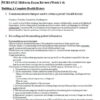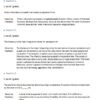Description
NURS 6512N Midterm Exam – Health Assessment
- Which type of speculum should be used to examine a patient’s tympanic membrane?
- When palpating the abdomen, you should note whether the liver is enlarged in the:
- Which question would be considered a leading question?
- Which of the following is the most vital nutrient?
- Mr. Franklin is speaking with you, the health care provider, about his respiratory problem. Mr. Franklin says, “I’ve had this cough for 3 days, and it’s getting worse.” You reply, “Tell me more about your cough.” Mr. Franklin states, “I wish I could tell you more. That’s why I’m here. You tell me what’s wrong!” Which caregiver response would be most appropriate for enhancing communication?
- Peritonitis produces bowel sounds that are:
- Mrs. Leonard brings her newborn infant into the pediatrician’s office for a first well-baby visit. As the health care provider, you teach her that newborns are more vulnerable to hypothermia due to:
- Which of the following is an “ABCD” characteristic of malignant melanoma?
- Tangential lighting is best used for inspecting skin:
- Which of the following occurs when firm pressure is used to apply the stethoscope’s bell end-piece to the skin?
- You are using an ophthalmoscope to examine a patient’s inner eye. You rotate the lens selector clockwise, then counterclockwise to compensate for:
- Small, minute bruises are called:
- A brief statement of the reason the patient is seeking health care is called the:
- Tuning forks with a frequency of 500 to 1000 Hz are most commonly used to measure:
- Which of the following organs is part of the alimentary tract?
- What finding is unique to the documentation of a physical examination of an infant?
- Your patient returns for a blood pressure check 2 weeks after a visit during which you performed a complete history and physical. This visit would be documented by creating a(n):
- Mr. Sanchez is a 45-year-old gentleman who has presented to the office for a physical examination to establish a new primary care health care provider. Which of the following describes a physical, not a cultural, differentiator?
- Fluorescing lesions are best distinguished using a(n):
- Mrs. Leonard brings her newborn infant into the pediatrician’s office for a first well-baby visit. As the health care provider, you teach her that newborns are more vulnerable to hypothermia due to:
- When taking a history, you should:
- The most common form of birth trauma of the scalp is:
- Mrs. G. reports an increase in her alcohol intake over the past 5 years. To screen her for problem drinking, you would use the:
- George Michaels, a 22-year-old patient, tells the nurse that he is here today to “check his allergies.” He has been having “green nasal discharge” for the last 72 hours. How would the nurse document his reason for seeking care?
- During physical examination of a 30-year-old Chinese man, you notice slight asymmetry of his face. The cranial nerve examination is normal. Your best action is to:
- In examining the neck of a 34-year-old female patient, you note that the uppermost ridge of the tracheal cartilage is at the:
- Tangential lighting is best used for inspecting skin:
- During percussion, a dull tone is expected to be heard over:
- When assessing abdominal pain in a college-age woman, one must include:
- When communicating with older children and teenagers, you should be sensitive to their:
- Mr. Abdul is a 40-year-old Middle Eastern man who presents to the office for a first visit with the complaint of new abdominal pain. You are concerned about violating a cultural prohibition when you prepare to do his rectal examination. The best tactic would be to:
- Mrs. Tuber is a 36-year-old patient who comes into the health center with complaints that her fingernails are not growing. Which structure is the site of new nail growth?
- You are examining a pregnant patient and have noted a vascular lesion. When you blanche over the vascular lesion, the site blanches and refills evenly from the center outward. The nurse documents this lesion as a:
- In counseling a client regarding nutrition education, you explain that linoleic acid, a major fatty acid, is thought to be essential for:
- The term denoting the caregiver’s need to do no harm to the patient is:
- Mrs. Webb is a 38-year-old patient who has been changing her lifestyle to eat in a healthy way and lose weight. During your health promotion education regarding her nutritional status, you explain the function of dietary protein as:
- You are palpating a patient’s thyroid and find that its broadest dimension measures 4 cm. The right lobe is 25% larger than the left. These data would indicate:
- Brittle nails are typical findings in:
- When assessing abdominal pain in a college-age woman, one must include:
- To correctly document absent bowel sounds, one must listen continuously for:
- Auscultation should be carried out last, except when examining the:
- Mr. Mathews is a 47-year-old patient who presents for a routine physical examination. On examination, you have noted a bruit heard over the thyroid. This is suggestive of:
- Mrs. Hartzell is a 34-year-old patient who has presented for nutritional counseling because she is a vegetarian. Deficiency of which of the following is a concern in the vegetarian diet?
- To approximate vocal frequencies, which tuning fork should be used to assess hearing?
- A 51-year-old woman calls with complaints of weight loss and constipation. She reports enlarged hemorrhoids and rectal bleeding. You advise her to:
- Mr. Jones is a 45-year-old patient who presents for a physical examination. On examination, you note costochondral beading, enlarged skull, and bowed legs and diagnose him with rickets. A deficiency of which fat-soluble micronutrient can result in rickets?
- Placing the base of a vibrating tuning fork on the midline vertex of the patient’s head is a test for:
- The attitudes of the health care professional:
- Macronutrients are so named because they:
- Cherry angiomas are a common finding in:
- Mr. Akins is a 78-year-old patient who presents to the clinic with complaints of hearing loss. Which of the following are changes in hearing that occur in the elderly? Select all that apply.
- Mr. Walters, a 32-year-old patient, tells you that his ears are “stopped up.” An objective assessment of this complaint is achieved by using the:
- After thorough inspection of the abdomen, the next assessment step is:
- In examining the neck of a 34-year-old female patient, you note that the uppermost ridge of the tracheal cartilage is at the:
- Nuchal rigidity is most commonly associated with:
- Tympanic thermometers measure body temperature when a probe is placed:
- To perform the Rinne test, place the tuning fork on the:
- As part of your health promotion education for a new patient, you explain that the risk factors for skin cancer include:
- Your patient is complaining of acute, intense sharp epigastric pain that radiates to the back and left scapula with nausea and vomiting. Based on this history, your prioritized physical examination should be to:
- Mr. and Mrs. Johnson have presented to the office with their infant son with complaints of ear drainage. When examining an infant’s middle ear, the nurse should use one hand to stabilize the otoscope against the head while using the other hand to:
- Mr. L. presents to the clinic with severe groin pain and a history of kidney stones. Mr. L.’s son tells you that, for religious reasons, his father wishes to keep any stone that is passed into the urine filter that he has been using. What is your most appropriate response?
- A guideline for history taking is for caregivers to:
- Peritonitis produces bowel sounds that are:
- Mr. Donalds is a 45-year-old roofer. Your inspection to determine color variations of the skin is best conducted:
- The most superior part of the stomach is the:
- A flat, nonpalpable lesion is described as a macule if the diameter is:
- When recording physical findings, which data are recorded first for all systems?
- Inspection of the abdomen should begin with the patient supine and the examiner:
- When assessing abdominal pain in a college-age woman, one must include:
- Mrs. Kinder is a 39-year-old patient who presents to the office with complaints of an earache. In explaining to the patient about the function of her ears, which ear structure would you tell her is responsible for equalizing atmospheric pressure when swallowing, sneezing, or yawning?
- The position on a clock, topographic notations, and anatomic landmarks:
- During an interview, tears appear in the patient’s eyes and his voice becomes shaky. Initially, you should:
- Ms. G. is being seen for her routine physical examination. She is a college graduate and president of a research firm. Although her exact salary is unknown, she has adequate health insurance. Most of the above information is part of Ms. G.’s _____ history.
- Which technique is most likely to result in the patient’s understanding of questions?
- A tool used to screen adolescents for alcoholism is the:
- A serous membrane that lines the abdominal cavity and forms a protective cover for many abdominal structures is the:
- Periods of silence during the interview can serve important purposes, such as:
- Expected hair distribution changes in older adults include:
- Mrs. Hartzell is a 34-year-old patient who has presented for nutritional counseling because she is a vegetarian. Deficiency of which of the following is a concern in the vegetarian diet?
- When hearing is evaluated, which cranial nerve is being tested?
- Sweat glands, hair, and nails are all formed from:
- A blood pressure cuff bladder should be long enough to:
- Which statement is true regarding the relationship of physical characteristics and culture?
- Under normal circumstances, how much water is lost daily by the body?
- Which of the following formats would be used for visits that address problems not yet identified in the problem-oriented medical record (POMR)?
- Which of the following is an expected change in the assessment of the thyroid during pregnancy?
- You are planning to palpate the abdomen of your patient. Which part of the examiner’s hand is best for palpating vibration?
- Regardless of the origin, discharge is described by noting:
- White, rounded, or oval ulcerations surrounded by a red halo and found on the oral mucosa are:
- Ms. Jones is a 31-year-old female patient who presents for a routine physical examination. Which examination technique will be used first?
- Pigmented, raised, warty lesions over the face and trunk should be assessed by an experienced practitioner who can distinguish:
- When are open-ended questions generally most useful?
- Before performing an abdominal examination, the examiner should:
- Which part of the information contained in the patient’s record may be used in court?
- When are open-ended questions generally most useful?
- Coarse, dry, and brittle hair is associated with which metabolic disorder?
- Your patient is complaining of acute, intense sharp epigastric pain that radiates to the back and left scapula with nausea and vomiting. Based on this history, your prioritized physical examination should be to:
- Before performing an abdominal examination, the examiner should:
- When examining the skull of a 4-month-old baby, you should normally find:
- A 17-year-old girl presents to the clinic for a sports physical. Physical examination findings reveal bradycardia, multiple erosions of tooth enamel, and scars on her knuckles. She appears healthy otherwise. You should ask her if she:









